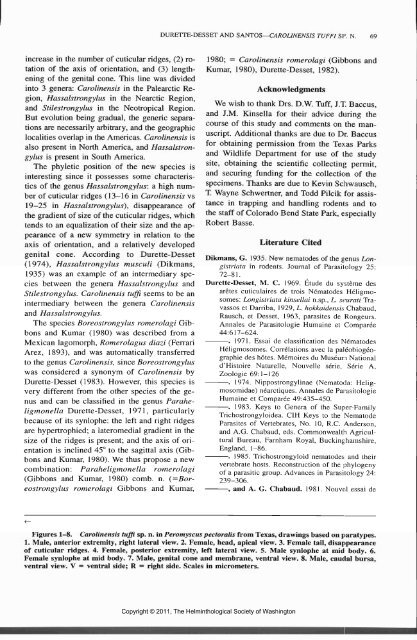Comparative Parasitology 67(1) 2000 - Peru State College
Comparative Parasitology 67(1) 2000 - Peru State College
Comparative Parasitology 67(1) 2000 - Peru State College
Create successful ePaper yourself
Turn your PDF publications into a flip-book with our unique Google optimized e-Paper software.
increase in the number of cuticular ridges, (2) rotation<br />
of the axis of orientation, and (3) lengthening<br />
of the genital cone. This line was divided<br />
into 3 genera: Carolinensis in the Palearctic Region,<br />
Hassalstrongylus in the Nearctic Region,<br />
and Stilestrongylus in the Neotropical Region.<br />
But evolution being gradual, the generic separations<br />
are necessarily arbitrary, and the geographic<br />
localities overlap in the Americas. Carolinensis is<br />
also present in North America, and Hassalstrongylus<br />
is present in South America.<br />
The phyletic position of the new species is<br />
interesting since it possesses some characteristics<br />
of the genus Hassalstrongylus: a high number<br />
of cuticular ridges (13-16 in Carolinensis vs<br />
19-25 in Hassalstrongylus), disappearance of<br />
the gradient of size of the cuticular ridges, which<br />
tends to an equalization of their size and the appearance<br />
of a new symmetry in relation to the<br />
axis of orientation, and a relatively developed<br />
genital cone. According to Durette-Desset<br />
(1974), Hassalstrongylus musculi (Dikmans,<br />
1935) was an example of an intermediary species<br />
between the genera Hassalstrongylus and<br />
Stile strongylus. Carolinensis tuffi seems to be an<br />
intermediary between the genera Carolinensis<br />
and Hassalstrongylus.<br />
The species Boreostrongylus romerolagi Gibbons<br />
and Kumar (1980) was described from a<br />
Mexican lagomorph, Romerolagus diazi (Ferrari<br />
Arez, 1893), and was automatically transferred<br />
to the genus Carolinensis, since Boreostrongylus<br />
was considered a synonym of Carolinensis by<br />
Durette-Desset (1983). However, this species is<br />
very different from the other species of the genus<br />
and can be classified in the genus Paraheligmonella<br />
Durette-Desset, 1971, particularly<br />
because of its synlophe: the left and right ridges<br />
are hypertrophied; a lateromedial gradient in the<br />
size of the ridges is present; and the axis of orientation<br />
is inclined 45° to the sagittal axis (Gibbons<br />
and Kumar, 1980). We thus propose a new<br />
combination: Paraheligmonella romerolagi<br />
(Gibbons and Kumar, 1980) comb. n. (=Boreostrongylus<br />
romerolagi Gibbons and Kumar,<br />
DURETTE-DESSET AND SANTOS—CAROLINENSIS TUFF/ SP. N. 69<br />
1980; = Carolinensis romerolagi (Gibbons and<br />
Kumar, 1980), Durette-Desset, 1982).<br />
Acknowledgments<br />
We wish to thank Drs. D.W. Tuff, J.T. Baccus,<br />
and J.M. Kinsella for their advice during the<br />
course of this study and comments on the manuscript.<br />
Additional thanks are due to Dr. Baccus<br />
for obtaining permission from the Texas Parks<br />
and Wildlife Department for use of the study<br />
site, obtaining the scientific collecting permit,<br />
and securing funding for the collection of the<br />
specimens. Thanks are due to Kevin Schwausch,<br />
T Wayne Schwertner, and Todd Pilcik for assistance<br />
in trapping and handling rodents and to<br />
the staff of Colorado Bend <strong>State</strong> Park, especially<br />
Robert Basse.<br />
Literature Cited<br />
Dikmans, G. 1935. New nematodes of the genus Longistriata<br />
in rodents. Journal of Parasilology 25:<br />
72-81.<br />
Durette-Desset, M. C. 1969. Etude du systeme des<br />
aretes cuticulaires de trois Nematodes Heligmosomes:<br />
Longistriata kinsellai n.sp., L. seurati Travassos<br />
et Darriba, 1929, L. hokkaidensis Chabaud,<br />
Rausch, et Desset, 1963, parasites de Rongeurs.<br />
Annales de Parasitologie Humaine et Comparee<br />
44:617-624.<br />
. 1971. Essai de classification des Nematodes<br />
Heligmosomes. Correlations avec la paleobiogeographie<br />
des holes. Memoires du Museum National<br />
d'Histoire Naturelle, Nouvelle serie, Serie A,<br />
Zoologie 69:1-126<br />
. 1974. Nippostrongylinae (Nematoda: Heligmosomidae)<br />
nearctiques. Annales de Parasitologie<br />
Humaine et Comparee 49:435-450.<br />
. 1983. Keys to Genera of the Super-Family<br />
Trichostrongyloidea. CIH Keys to the Nematode<br />
Parasites of Vertebrates, No. 10, R.C. Anderson,<br />
and A.G. Chabaud, eds. Commonwealth Agricultural<br />
Bureau, Farnham Royal, Buckinghamshire,<br />
England, 1-86.<br />
. 1985. Trichostrongyloid nematodes and their<br />
vertebrate hosts. Reconstruction of the phylogeny<br />
of a parasitic group. Advances in <strong>Parasitology</strong> 24:<br />
239-306.<br />
, and A. G. Chabaud. 1981. Nouvel essai de<br />
Figures 1-8. Carolinensis tuffi sp. n. in Peromyscus pectoralis from Texas, drawings based on paratypes.<br />
1. Male, anterior extremity, right lateral view. 2. Female, head, apical view. 3. Female tail, disappearance<br />
of cuticular ridges. 4. Female, posterior extremity, left lateral view. 5. Male synlophe at mid body. 6.<br />
Female synlophe at mid body. 7. Male, genital cone and membrane, ventral view. 8. Male, caudal bursa,<br />
ventral view. V = ventral side; R = right side. Scales in micrometers.<br />
Copyright © 2011, The Helminthological Society of Washington
















